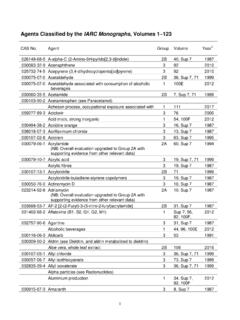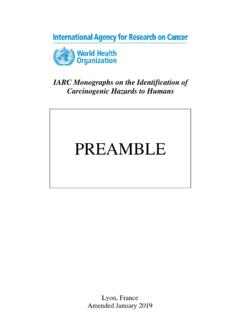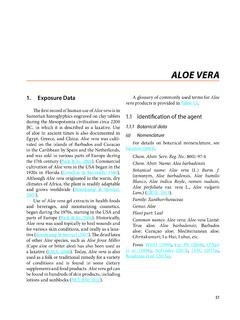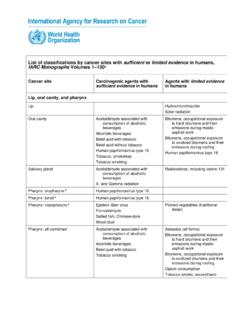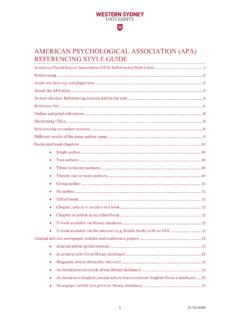Transcription of A. INTRODUCTION 1. History of Use of Traditional Herbal ...
1 A. INTRODUCTION1. History of Use of Traditional Herbal MedicinesBy definition, Traditional use of Herbal medicines implies substantial historical use,and this is certainly true for many products that are available as Traditional Herbal medi-cines . In many developing countries, a large proportion of the population relies on tradi-tional practitioners and their armamentarium of medicinal plants in order to meet healthcare needs. Although modern medicine may exist side-by-side with such traditionalpractice, Herbal medicines have often maintained their popularity for historical andcultural reasons. Such products have become more widely available commercially, espe-cially in developed countries. In this modern setting, ingredients are sometimes marketedfor uses that were never contemplated in the Traditional healing systems from which theyemerged.
2 An example is the use of ephedra (= Ma huang) for weight loss or athleticperformance enhancement (Shaw, 1998). While in some countries, Herbal medicines aresubject to rigorous manufacturing standards, this is not so everywhere. In Germany, forexample, where Herbal products are sold as phytomedicines , they are subject to thesame criteria for efficacy, safety and quality as are other drug products. In the USA, bycontrast, most Herbal products in the marketplace are marketed and regulated as dietarysupplements, a product category that does not require pre-approval of products on thebasis of any of these criteria. These matters are covered extensively in Section 3 role of Herbal medicines in Traditional healingThe pharmacological treatment of disease began long ago with the use of herbs(Schulz et al.)
3 , 2001). Methods of folk healing throughout the world commonly usedherbs as part of their tradition. Some of these traditions are briefly described below,providing some examples of the array of important healing practices around the worldthat used herbs for this Chinese medicineTraditional Chinese medicine has been used by Chinese people from ancient animal and mineral materials have been used, the primary source of remediesis botanical. Of the more than 12 000 items used by Traditional healers, about 500 are incommon use (Li, 2000). Botanical products are used only after some kind of processing, 43 which may include, for example, stir-frying or soaking in vinegar or wine. In clinicalpractice, Traditional diagnosis may be followed by the prescription of a complex andoften individualized Chinese medicine is still in common use in China.
4 More than half thepopulation regularly uses Traditional remedies, with the highest prevalence of use in ruralareas. About 5000 Traditional remedies are available in China; they account for approxi-mately one fifth of the entire Chinese pharmaceutical market (Li, 2000). Traditional medicineMany Herbal remedies found their way from China into the Japanese systems oftraditional healing. Herbs native to Japan were classified in the first pharmacopoeia ofJapanese Traditional medicine in the ninth century (Saito, 2000). Traditional medicineAyurveda is a medical system primarily practised in India that has been known fornearly 5000 years. It includes diet and Herbal remedies, while emphasizing the body,mind and spirit in disease prevention and treatment (Morgan, 2002). of Traditional Herbal medicines into Europe, the USA andother developed countriesThe desire to capture the wisdom of Traditional healing systems has led to a resur-gence of interest in Herbal medicines (Tyler, 2000), particularly in Europe and NorthAmerica, where Herbal products have been incorporated into so-called alternative , complementary , holistic or integrative medical the latter part of the twentieth century, increasing interest in self-care resultedin an enormous growth in popularity of Traditional healing modalities, including the useof Herbal remedies; this has been particularly true in the USA.
5 Consumers have reportedpositive attitudes towards these products, in large part because they believe them to be of natural rather than synthetic origin, they believe that such products are more likely tobe safe than are drugs, they are considered part of a healthy lifestyle, and they can helpto avoid unnecessary contact with conventional western medicine. While centuries of use in Traditional settings can be used as testimony that a parti-cular Herbal ingredient is effective or safe, several problems must be addressed as theseingredients are incorporated into modern practice. One problem is that ingredients once used for symptomatic management in tradi-tional healing are now used in developed countries as part of health promotion or diseaseprevention strategies; thus, acute treatment has been replaced by chronic exposure ( , Herbal products used for weight loss, Allison et al.)
6 , 2001). This means that a statementabout thousands of years of evidence that a product is safe may not be valid for the wayIARC MONOGRAPHS VOLUME 8244the product is now being used. This does not expressly mean that an ingredient is unsafe;it does mean that safety in the modern context cannot be assumed. A second problem is that efficacy and effectiveness have rarely been demonstratedusing modern scientific investigations. An evidence-based approach to this issue hasonly recently been implemented, and the results reveal that for most Herbal products,considerable gaps in knowledge need to be remedied before one can be convinced abouttheir of the most difficult issues to contend with in translating Traditional herbalpractices into conventional western medicine is the individualization of prescriptionscontaining multiple Herbal and other ingredients.
7 There is little incentive for standar-dization of products for a mass market, when the intention has been to provide an indivi-dual prescription. To the small grower or the traditionally trained herbalist, standar-dization means understanding the growth conditions, the time of harvesting, the mannerof extraction or other preparation of material so that a reliable (albeit small amount of)active ingredient can be offered to people. To the manufacturer or distributor of largequantities that will be sold in a supermarket or a health food store, standardization refersto industrial production under defined conditions, using so-called Good ManufacturingPractices (GMP) (Food & Drug Administration, 2002) akin to those used for the USA, there is both small-scale and large-scale production of Herbal productsand there can be wide variation in their content and quality in the marketplace.
8 Regu-lations in the USA do not yet require that dietary supplement manufacturers adhere tostandard manufacturing practices, and so quality is not guaranteed (see Section 3). Thepublic becomes discouraged by reports that products taken from store shelves do notconsistently contain the ingredients or in the amounts that are claimed on the Herbal products in common use, evidence of efficacy may be based upon tradi-tional use, testimonials, clinical studies, both controlled and uncontrolled, and rando-mized, double-blind, placebo-controlled trials. For the most part, however, there is a lackof systematic clinical studies to support of some Herbal ingredients has been recently called into question, in partbecause of the identification of adverse events associated with their use and, increasingly,because of the demonstration of clinically relevant interactions between herbs and pres-cription events (stroke, heart attacks, heart-rate irregularities, liver toxicity, seizures,psychoses and death) associated with use of ephedra for weight loss, body-buildingeffects and increased energy or kava-kava (also known as kawa)
9 , widely used in Europeand increasingly in Canada to treat anxiety, nervousness, insomnia, pain and muscletension, for example, have caused some countries to issue regulations restricting orbanning these products ( health Canada Online, 2002a,b). Only a few herbs incommon use have been suspected of causing cancer. These include Aristolochia,Rubiatinctorum, Morinda officinalisand Senecio riddellii, as discussed in detail below. SOME Traditional Herbal MEDICINES452. Use of Traditional Herbal Medicines in Developed , type and botanical dataPlants and their secondary metabolite constituents have a long History of use inmodern western medicine and in certain systems of Traditional medicine, and are thesources of important drugs such as atropine, codeine, digoxin, morphine, quinine of Herbal medicines in developed countries has expanded sharply in the latterhalf of the twentieth century.
10 Monographs on selected herbs are available from a numberof sources, including the European Scientific Cooperative on Phytotherapy (ESCOP,1999), German Commission E (Blumenthal et al., 1998) and the World health Organi-zation (WHO, 1999). The WHO monographs, for example, describe the herb itself by anumber of criteria (including synonyms and vernacular names) and the herb partcommonly used, its geographical distribution, tests used to identify and characterize theherb (including macroscopic and microscopic examination and purity testing), the activeprinciples (when known), dosage forms and dosing, medicinal uses, pharmacology,contra-indications and adverse reactions. Other resources that provide detailed infor-mation about Herbal products in current use include the Natural Medicines Compre-hensive Database (Jellin, 2002) and NAPRALERT (NAtural PRoducts ALERT) (2001).
